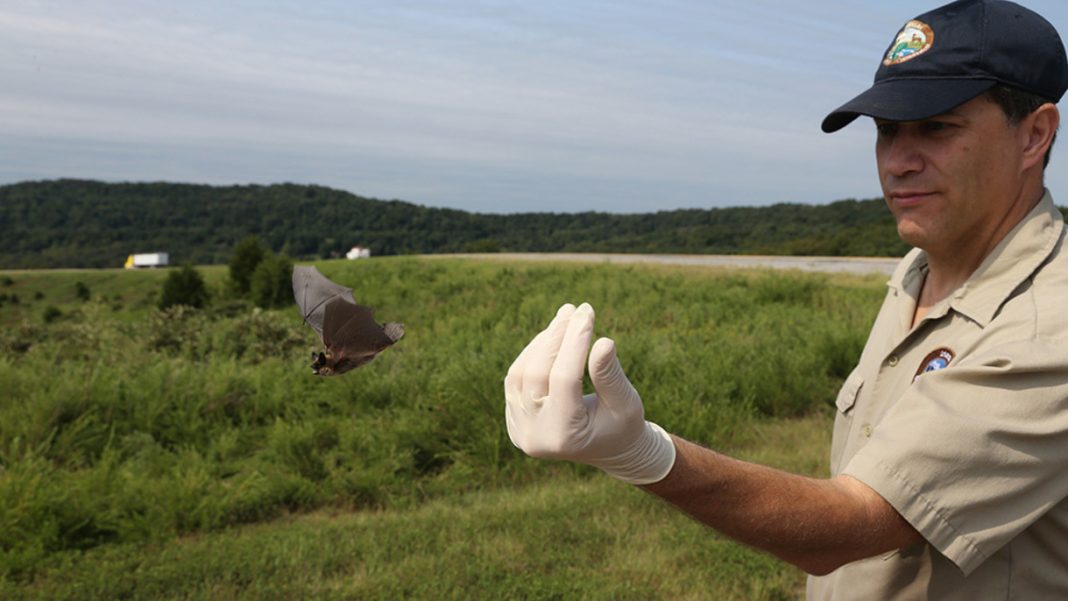Jim Harris Managing Editor Arkansas Wildlife Magazine
LITTLE ROCK – Bat Week, an annual international celebration of the role of bats in nature, runs all this week and, naturally, through Halloween, Oct. 31. It also affords the opportunity for Arkansans not only to think about these creatures and their role in our outdoors, but what people can do to reverse some dangers haunting some bat species in The Natural State.
Two species in Arkansas have seen their populations take such precipitous drops that they are on the proposed list of the U.S. Fish and Wildlife Service for categorization as endangered. In a study in the Ouachita National Forest by the U.S. Forest Service, the northern long-eared bat has seen a 98 percent fall in numbers. In September, the USFWS proposed listing the tricolored bat as endangered. Both species have been harmed in great numbers by white-nose syndrome, a fungus found in caves.
The tricolored bat “commonly was found in Arkansas caves, but the population has dropped 70-80 percent, which are numbers similar to what has been seen nationwide,” Blake Sasse, the Arkansas Game and Fish Commission’s statewide nongame mammal program coordinator, said. “Both were very common in Arkansas before white-nose syndrome arrived.”
White-nose syndrome is a fungus that originally was found in caves in Europe and Asia. Fungus gets on the bats while they are hibernating in caves during winter. “It causes damage to their tissues and it makes them wake up more often than they normally would,” Sasse said. “When they’re awake when they should be hibernating, they use more energy than they normally would and they end up starving to death.”
He said white-nose syndrome most likely made it to these shores by being carried via spores on clothing of spelunkers, who then explored this area’s caves, and it’s been in Arkansas about 10 years, harming previously unexposed bats. The fungus can grow in any cave-like environment, Sasse said, and it has been found on bats hibernating in culverts as well.
“Before white-nose, the northern long-eared bat was probably the most common bat found in the Ozark and Ouachita national forests. The tricolored was fairly common,” Sasse said. The tricolored bat is named for the three different bands of color found in each strand of hair on the bat, he said.
Humans’ best efforts now are to do whatever they can to stop spreading the fungus. Hence the many posted protocols that cave visitors will find such as on trips to Blanchard Springs Caverns north of Mountain View in Stone County to decontaminate their shoes and clothing before and after entering. “If people go into any caves or mines, there is a protocol for cleaning their clothes, gear and equipment to make sure they don’t spread it,” Sasse said.
Visit whitenosesyndrome.org for info on how to clean clothes and gear when exploring caves or mines.
“Other things that people can do for bats if they want to help them is to build and put up a bat house,” Sasse mentions. www.agfc.com has a document under its free brochures page (https://drive.google.com/file/d/1R52Z4KbgSfchcavtnWczCszzdxYfPYO0/view) that provides a good starting place to providing a summer home for bats.
Around the state, the little brown, big brown, southeastern, small footed, gray and Indiana bats have been found with white-nose syndrome or have died from the disease. For other Arkansas species – eastern red, silver-haired, Rafinesque’s big-eared and Ozark big-eared bat have been found with the fungus but have not been confirmed to have white-nose syndrome. The big brown bat, along with the Mexican free-tailed bat, are often seen in urban settings.
Another bat in Arkansas that has been on the endangered list, the gray bat, is seeing populations rise due to protections in place in caves where they spend their summers, Sasse said, adding, “Not all the news is bleak.”
The gray bat’s decline wasn’t due to white-nose syndrome, but rather to humans driving them out of caves during hibernation or during maternity periods with their young. Unlike many other bats, gray bats use caves year-round. To help the gray bat, biologists have put up fences, or “bat gates,” in openings of caves that consist of a horizontal bar where bats can fly through but people can’t squeeze in.
“Once you keep people away from them, they are fine,” Sasse said.
Worldwide, there are more than 1,400 species of bats — nearly 20 percent of all mammal species. According to Bat Conservation International, they are vital to the health of the environment and economy. Most bats in North America, including all 16 Arkansas species, eat insects, including moths, beetles, aquatic insects and flies. A single bat can eat up to its body weight in insects each night. Eating these insects helps protect food crops and forests from insect pests, saving farmers and forest managers billions of dollars each year.
Many bats eat pollen, nectar or fruit and are vital for pollinating flowers and spreading seeds that grow new plants and trees.
Bats are also the only mammal that can fly (some other mammals can “glide”). The bat’s wing is actually a modified “hand.” And, contrary to popular belief, bats have good eyesight, though the main technique for most species for navigating or locating prey is using echolocation: emitting high-pitched sounds that bounce off obstacles in their path, like trees, other bats, buildings and food.
Although nearly 70 percent of bat species feed primarily on insects, some are carnivorous and will eat rodents, frogs and fish. And, in case the Halloween trick-or-treaters who were wondering when they go out Monday evening, only three species of bats feed on animal blood (two of these specializing in bird blood), none of which reside in the United States.
For more information on Bat Week, which officially started Oct. 24, visit https://batweek.org/.






